jimpudar
Member
- Joined
- Sep 20, 2020
- Messages
- 2
The Fear
I have had my Domino XL for a little over a month now, and have used it on a couple projects. It definitely has a learning curve, so I wasn't too worried when I wasn't getting perfect results.
However, I noticed there was a fairly reproducible skew (i.e. crooked, not level, not parallel) to my mortises so I started doing a little research here on the forum.
After finding the following threads, I started to worry that this might be a widespread problem:
Based on the recommendations in those threads, I decided to start troubleshooting.
Initial Troubleshooting
Lots of people suggested first setting the fence height in the storage position, then once the height is locked down tilting it down to 90 degrees. I tried this, but was still getting the same (fairly) consistently skewed mortises.
The next thing to try seemed to be taking the fence out of the equation and registering directly against the base of the Domino. This is when I started taking some pictures. Here you can see the slight skew to the mortise in this piece of curly maple: the left side is pretty bang on 10mm from the bottom edge of the piece, but the right side is a bit lower at around 9.7mm. It's bad enough that you can easily see it by eye in person.
View attachment 1
When creating this mortise, I had the maple clamped down to my workbench and was putting pressure down and forward on the Domino the entire time. I also made sure to plunge relatively slowly. I was using the 10mm XL cutter with a plunge depth of 25mm.
I started wondering if I could still be the problem somehow. Is my bench not perfectly flat? Was I not putting enough downward pressure on the Domino? Plunging too slowly?
I decided to perform the "mother of all tests" to finally determine once and for all whether my motor was really misaligned to the domino base.
The Mother of All Tests
Here is my test setup. I have my homemade MFT top (created with the excellent Parf system) securely clamped to my 500 lbs workbench using Veritas holdfasts. I can't move the MFT top with a deadblow hammer. On top of the MFT top is a precision granite surface plate, flat to .000025".
View attachment 2
I milled up two pieces of red oak perfectly flat and square.
View attachment 3
I then marked a perpendicular line using my best square and thinnest pencil.
View attachment 4
I then clamped the first board to the granite block using two Festool cam clamps. I verified that I couldn't budge the board.
View attachment 5
Next, I cleaned the bottom of the Domino and registered it against the wood and the granite.
View attachment 6
Finally, I took the plunge. I did so slightly more quickly than I had been doing in my previous tests after reading in the supplementary manual that too slow a plunge could cause mortise skew (although how it could cause this I have absolutely no idea). I also made sure to hold the Domino down against the granite with nearly my entire body weight. The resulting mortise looked very clean and to my eye parallel.
View attachment 7
I repeated the procedure for the other board, and found myself with another perfect looking mortise.
View attachment 8
However, the true test would be to join the boards together and see if they showed the symptoms of skew. I carefully inserted a 10x50mm tenon into the mortises and was amazed to see the boards were joined absolutely perfectly!
View attachment 9
Conclusions
Until I did these tests, I was convinced by my seemingly consistently skewed mortises and by the numerous forum posts that there was something wrong with my Domino and that I would need to send it in for re-alignment. I was especially worried that I, like others in the forum, would have Festool send it right back telling me "nothing is wrong".
Given the consistency of the skew I was seeing and that others have experienced, I have to believe that there is some issue with our plunging technique. I will continue to work on my technique and see if I can get these perfect mortises outside of "laboratory" conditions - I'm sure it's possible now.
Hopefully this post will be useful to somebody. I would appreciate any ideas on how my plunging technique can be improved, and would be happy to run additional tests if they can help somebody out.
I have had my Domino XL for a little over a month now, and have used it on a couple projects. It definitely has a learning curve, so I wasn't too worried when I wasn't getting perfect results.
However, I noticed there was a fairly reproducible skew (i.e. crooked, not level, not parallel) to my mortises so I started doing a little research here on the forum.
After finding the following threads, I started to worry that this might be a widespread problem:
- https://www.festoolownersgroup.com/festool-tool-problems/tolerances-for-domino-xl-skew/
- https://www.festoolownersgroup.com/festool-tool-problems/new-domino-xl-alignment-issue/
- https://www.festoolownersgroup.com/festool-tool-problems/domino-xl-700-mortise-not-cutting-parallel-to-fence/
- https://www.festoolownersgroup.com/festool-tool-problems/domino-xl-mortise-not-level/
Based on the recommendations in those threads, I decided to start troubleshooting.
Initial Troubleshooting
Lots of people suggested first setting the fence height in the storage position, then once the height is locked down tilting it down to 90 degrees. I tried this, but was still getting the same (fairly) consistently skewed mortises.
The next thing to try seemed to be taking the fence out of the equation and registering directly against the base of the Domino. This is when I started taking some pictures. Here you can see the slight skew to the mortise in this piece of curly maple: the left side is pretty bang on 10mm from the bottom edge of the piece, but the right side is a bit lower at around 9.7mm. It's bad enough that you can easily see it by eye in person.
View attachment 1
When creating this mortise, I had the maple clamped down to my workbench and was putting pressure down and forward on the Domino the entire time. I also made sure to plunge relatively slowly. I was using the 10mm XL cutter with a plunge depth of 25mm.
I started wondering if I could still be the problem somehow. Is my bench not perfectly flat? Was I not putting enough downward pressure on the Domino? Plunging too slowly?
I decided to perform the "mother of all tests" to finally determine once and for all whether my motor was really misaligned to the domino base.
The Mother of All Tests
Here is my test setup. I have my homemade MFT top (created with the excellent Parf system) securely clamped to my 500 lbs workbench using Veritas holdfasts. I can't move the MFT top with a deadblow hammer. On top of the MFT top is a precision granite surface plate, flat to .000025".
View attachment 2
I milled up two pieces of red oak perfectly flat and square.
View attachment 3
I then marked a perpendicular line using my best square and thinnest pencil.
View attachment 4
I then clamped the first board to the granite block using two Festool cam clamps. I verified that I couldn't budge the board.
View attachment 5
Next, I cleaned the bottom of the Domino and registered it against the wood and the granite.
View attachment 6
Finally, I took the plunge. I did so slightly more quickly than I had been doing in my previous tests after reading in the supplementary manual that too slow a plunge could cause mortise skew (although how it could cause this I have absolutely no idea). I also made sure to hold the Domino down against the granite with nearly my entire body weight. The resulting mortise looked very clean and to my eye parallel.
View attachment 7
I repeated the procedure for the other board, and found myself with another perfect looking mortise.
View attachment 8
However, the true test would be to join the boards together and see if they showed the symptoms of skew. I carefully inserted a 10x50mm tenon into the mortises and was amazed to see the boards were joined absolutely perfectly!
View attachment 9
Conclusions
Until I did these tests, I was convinced by my seemingly consistently skewed mortises and by the numerous forum posts that there was something wrong with my Domino and that I would need to send it in for re-alignment. I was especially worried that I, like others in the forum, would have Festool send it right back telling me "nothing is wrong".
Given the consistency of the skew I was seeing and that others have experienced, I have to believe that there is some issue with our plunging technique. I will continue to work on my technique and see if I can get these perfect mortises outside of "laboratory" conditions - I'm sure it's possible now.
Hopefully this post will be useful to somebody. I would appreciate any ideas on how my plunging technique can be improved, and would be happy to run additional tests if they can help somebody out.
Attachments
-
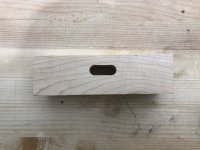 01_skewed_mortise.jpeg130.9 KB · Views: 269
01_skewed_mortise.jpeg130.9 KB · Views: 269 -
 02_test_setup.jpeg105.8 KB · Views: 206
02_test_setup.jpeg105.8 KB · Views: 206 -
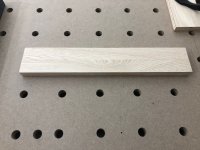 03_milled_boards.jpeg159.1 KB · Views: 155
03_milled_boards.jpeg159.1 KB · Views: 155 -
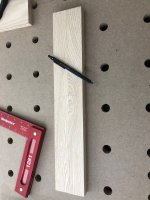 05_marked.jpeg172.3 KB · Views: 175
05_marked.jpeg172.3 KB · Views: 175 -
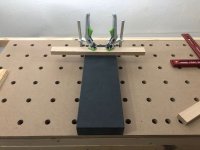 06_clamped.jpeg115.2 KB · Views: 154
06_clamped.jpeg115.2 KB · Views: 154 -
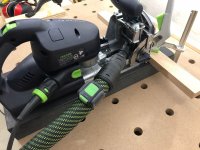 08_domino_right.jpeg159.6 KB · Views: 187
08_domino_right.jpeg159.6 KB · Views: 187 -
 09_first_mortise.jpeg147 KB · Views: 223
09_first_mortise.jpeg147 KB · Views: 223 -
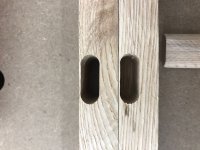 10_side_by_side_mortises.jpeg131.3 KB · Views: 231
10_side_by_side_mortises.jpeg131.3 KB · Views: 231 -
 11_perfect_join.jpeg110.3 KB · Views: 161
11_perfect_join.jpeg110.3 KB · Views: 161
